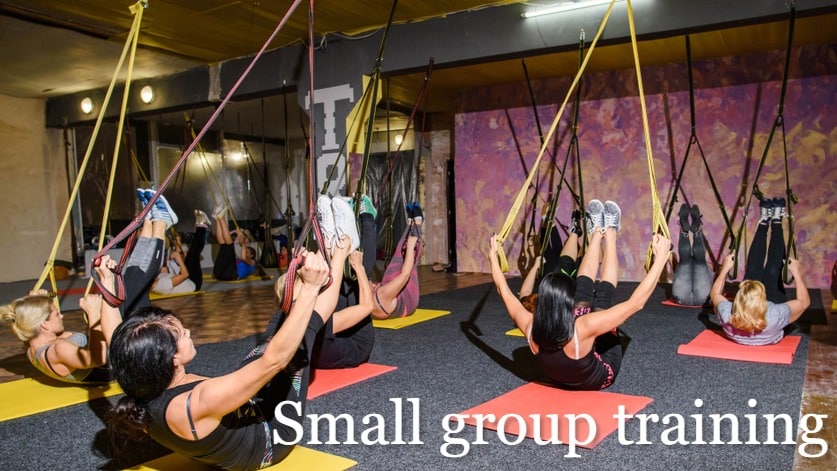Hey there! Yes, you. I want to introduce you to an amazing way to boost your personal training business and skyrocket your income.
Many personal trainers struggle to find the groove between earning what they deserve and charging what is fair and reasonable.
It’s not complicated, but it’s an often overlooked service in the fitness industry.
And that is small group training. What do I mean by small group training?
I also highly recommend that you take the quiz and find out which personal trainer certification is best for your career goals.
A group of no more than 10 individual clients, all coming together to do a progressive exercise program.
The main benefit of small group training is you boost your per-session revenue while also discounting the cost each client has to pay, all while retaining the attention to detail that comes with a regular one on one session.
Sounds like a win-win situation, correct? Well, that’s because it is, and I’ll show you how to set it up.
What Is Small Group Training?

Small group training, as I explained, is training a group of no more than 10 individuals and no less than two.
Unlike regular group training, which will have a set program that doesn’t progress and allows for a constant flux of drop-ins and non-committed trainees, small group training adds the same value as a one-on-one client relationship in a group setting.
Large group training is typically an aerobic session with no intended goal in terms of progressive adaptation for participants.
Examples of a group or large group training are yoga, Zumba, boot camps, and spin classes.
These classes have a program that never changes or progresses and is just workouts for working out.
There’s nothing wrong with this sort of training, but it has a rather low-value proposition when considering client specificity and progressive outcomes/goals.
This low value also translates to a low-income potential, so training large groups typically net a small flat rate.
Even though you have used the same amount of time and energy to conduct fitness services, this is true.
Small group training, on the other hand, means your clients are gaining the value of progressive fitness training while in a close-knit group which has its benefits from the camaraderie and moral support aspect.
Small group training implements a periodized program that typically stretches over 3 months to improve fitness and body composition progressively.
You can divide this periodization into 3 months, for example, each month focusing on a different aspect or pillar of fitness.
The first month can go into activation. Allowing your client’s bodies to adapt to the oncoming training stimuli through workouts that ignite neuromuscular activation and motor unit innervation.
This will build stability, coordination, range of motion, and balance for the following strength and power phases.
Once clients have adequately progressed in strength, power, and endurance, you can move to the final phase of your program, skills, and conditioning.
In this phase, you are now polishing the functional tools and ingraining the training methods gained throughout the program.
With this level of value provided, your income potential drastically shoots up, but at the same time, it remains attractive to clients.
Pros and Cons of Small Group Training

So far, I’ve shed light on what small group training is and its benefits, but as with anything, your best approach is to weigh the potential advantages and the likely drawbacks and decide how to make things work from there.
Pros
- Small group training earns you more for the same amount of work
- Small group training costs clients less for the same value in results
- Small group training is easy to implement if you already have 1-on-1 experience
- Small group training gives clients the “tribe vibe” benefits
- Small group training can be done as an online service
- Small group training gives you a broader sphere of influence for good reviews, referrals, and word-of-mouth marketing.
Cons
- Small groups can be tricky to build
- Individuals have different set points in fitness and motivation, so progression may not be uniform.
- Optimal success is subject to the consistent availability of all members, which is not always possible.
- Friction between members can happen, which can complicate the group dynamic.
- Although easier to manage than large groups, small group training does suffer from some loss of attention to detail
With all that said, I find the pros outweigh the cons, especially from an income and revenue perspective, which is what this guide is all about.
13 Pro Tips For Small Group Training Success

1. Get Your Group Trainer Credentials
The first thing I will ALWAYS suggest you do when venturing into any aspect of the fitness business is get certified.
Credentials are king, and while new clients won’t always look for your credentials immediately, there will be a point in your business relationship where your qualifications count.
Aside from credibility, having a cert allows you access to insurance and liability coverage which is essential when running your fitness business.
If you’re working out of a gym, you’ll almost certainly be required to have a certification.
When it comes to small group training, I suggest a group training certification, of course.
From a knowledge perspective, you’ll also learn how to manage small groups from a programming and instructional perspective.
Training a group of people has different coaching psychology from training one-on-one clients, and with the right certification, you’ll be introduced to this concept for effective implementation.
For example, dealing with multiple personalities means dealing with different limiting factors, levels of motivation, and discipline.
It also means dealing with potential personality conflicts between group members.
That’s why when it comes to small group training, I always suggest getting together an established group of people that already function well together.
But we’ll get to that later.
My best suggestion for a group training certification is the NASM GPTS. Other agencies such as ACE, NESTA, and ISSA all offer group training certs.
You might be confused about which cert will ultimately work for your aspirations and curation.
If you need help with that decision, I suggest you take the quiz here.
It will help you sort through the various options to make the best choice for yourself and your PT career goals.
2. Start With 1 Client
We all have to start somewhere, and when it comes to building a great small group training operation, sometimes just starting with a one-on-one client might be your best bet.
A client who has experienced favorable interaction and achieved results under you will likely provide an excellent record of what you can do for others.
This is especially effective if those others are friends, family, or colleagues. The influence is a key factor, especially in positive outcomes.
One easy way to build a small group off just one client is to leverage the benefits of reduced cost.
Your client will get the same value in results and achieving goals while making decent savings.
They also get the support, motivation, and fun of training with their besties or family.
Starting with one client and building a group around them also allows you to have one group member who acts as an intermediary between you, the trainer, and the clients.
This group dynamic has benefits in building a strong, cohesive structure and team balance for more effective results and group accountability.
That’s because your client number 1 will be able to vouch for your process to the others while also communicating the group’s needs to you.
Start by asking your client for referrals, then ask if they would be interested in a small group scenario with close friends or family.
On the flip side, you also have the opportunity to convert group-class clients into one-on-one clients if they see value in a more focused, individualized approach.
3. Market Your Expertise

Marketing your value is a big part of getting your small group training game on. To effectively reach out to the clients you want to convert, they need to know where to go.
Exclusive PTP CPT Offers |
||
|---|---|---|
Most Popular Cert | Best Online NCCA Cert | Best Study Materials |
Gold Standard Cert | A Good Option | Best CPT for you?  |
Positioning yourself effectively requires a multi-faceted approach.
I will introduce you to some key marketing strategies for optimizing your presence and making your expertise known in whatever capacity you undertake as a fitness pro.
In the meantime, I want you to look at where you are making yourself visible to potential clients and how you present your experience and credentials.
If you are working out of a big box gym, chances are you have constant access to many potential clients.
This is a great place to start, but it is limited in the impact you can have as a stand-out small-group trainer.
You need to take things online and create your platform for self-promotion. A big box gym will only promote you within the scope of the gym’s business model and interests.
So take your value and own it.
Social media is a great way to present your expertise.
In your profile description or bio, always include your scope of expertise and your credentials. You want the first thing people know about you to be what you can do and how qualified you are.
Going beyond this, plug your services into the content you share.
In your Instagram captions, present a common problem or desire your audience might have and cap it off by offering a solution like small group training.
Your website should also be optimized in such a way as to lead traffic to your small group training services through useful navigation strategies.
Always include your small group training expertise in your taglines and stories as part of the normal call-to-action to attract prospects to this service.
4. Target Existing Groups

I briefly touched on using one-on-one clients to build a small group of clients.
You can also use a similar outreach method to target an existing group.
People who normally function in a cohesive group, such as siblings, besties, work colleagues, or classmates, are a good choice.
One good way of appealing to existing groups is by reaching out to schools, universities, or colleges.
These institutions will have no shortage of small group pockets, many of whom have a positive dynamic and can encourage and offer morale to each other in a workout setting.
Another easy way to get an entire existing group is to use a corporate wellness or team-building approach.
Corporate wellness is always in demand for health and fitness solutions, given that health and the benefits of regular exercise lead to improved productivity.
The corporate sector is, therefore, a gold mine when it comes to small-group training prospects.
Sometimes, you don’t even need to go that far and deep. You can gain a decent amount of small-group potential within your own friend and family circles.
Many trainers tend to avoid approaching their social circles for clients. People you know and have personal bonds with tend to expect a discount on everything, if not free service, and you might also feel wary about charging a sibling, parent, or best friend for anything.
That’s where the beauty of small group training comes in.
Because clients can pay much less for your services, you can turn this into an opportunity where both sides win.
The win-win aspect of small group training is one thing I will always vouch for.
5. Set Your Group Size Limit

My suggestion for a small group limit cap is 10 clients.
Anything beyond this, your effort and strategies shift from the more personalized potential to a more large group blanket program approach.
With enough skill and attention, I’ve found a group of no more than 10 clients is easy to manage and give personalized attention to.
It’s also easier to track the progress of individuals. The smaller the number of them you need to tend to.
Another benefit of limiting the group size, besides the admin of it all, is the marketing potential.
You’re probably wondering how group size determines marketing potential.
Well, the secret here lies in scarcity marketing.
Scarcity marketing is a potent play in consumer psychology.
By limiting the amount of time that a service or product is available, you end up increasing demand.
Scarce or limited things inspire a sense of aspiration or exclusivity that people buy into.
By using a “Limited Space Available” or similar calls to action, you can boost sales tremendously by making your small group training packages more attractive due to limited availability.
You can take this further and add a time limit to your service availability.
Of course, you will naturally have a time limit since once your intake capacity is met, you will be focused on that group for the program duration.
But a smart move would be to use this reality as a form of scarcity marketing to boost your sales rate.
6. Niche Down

Niching down is one of the core principles of building and growing a solid business.
Find something that people want and hardly anyone else is offering, and add your unique twist to differentiate further and sell, sell, sell.
Niching down, as the name suggests, essentially means carving a niche.
In the world of fitness, having a niche is pivotal to success.
With the constant influx of new trainers every year, the burgeoning competition level compels you to stand up and stand out.
Small group training is a niche, so you’ve already got the ball rolling by focusing on a specific industry segment.
Taking this further and giving your training its unique focus.
Perhaps you could hone in on a specific method, like offering HIIT classes or functional mobility programs.
You can also focus your small group training service on specific population groups or demographics.
An example of this is offering training to kids or senior citizens. Focusing on specific demographics can help you to focus on your business and less on what the competition is doing, which is where the real growth comes from.
Developing a niche also sends a message. You can go from being another PT service to a stand-out reputable brand.
With a reliable approach to exercise programming, and a compelling message and brand image, you can take your group training experience from humble beginnings to a household empire.
CrossFit and F45 are prime examples of how small group training can morph into a profitable institution.
7. Create A Program Template

I just mentioned having a reliable approach to exercise programming. This is essential to developing a structure that works.
You want to have a standardized way of doing things, but at the same time, you want to be able to modify according to personal preference and shifting scenarios.
As any personal trainer knows, things are constantly changing on clients’ path to their goals.
Exclusive PTP CPT Offers |
||
|---|---|---|
Most Popular Cert | Best Online NCCA Cert | Best Study Materials |
Gold Standard Cert | A Good Option | Best CPT for you?  |
As your client progresses, resource expenditure and requirements naturally shift, and the load, frequency, and volume of training change progressively with adaptation.
Clients can also suffer setbacks, our unforeseen events based on stuff not detected in your analysis phase.
All these things are compounded by the fact that you’re dealing with up to 10 unique individuals with their needs and wants in a small group training setting.
So working within a framework that can be scaled within reasonable parameters when and where needed.
For example, having a variety of training loads according to different 1RM readings as per individual while maintaining the same exercise methodology.
The key to developing a template is to remain true to the framework and not disturb the fundamental structure.
If you do this, your programming can easily disappear, making you feel as lost as your clients.
Only change where necessary and not just for the sake of changing. You still want to be able to challenge your clients. Otherwise, the sense of achievement and any effective results could be lost.
8. Use Periodization
Having a structured template is one thing, but how it’s structured is another.
For a mall group training system, you should ideally go for a periodized program that progresses over multiple phases and training effects.
I touched on this briefly, but to go further in, I suggest an undulating periodization programming template.
Periodization means there is a set time frame for completion.
Having a deadline for completion is another great selling point.
People like beginnings and happy endings; it’s your job to guide your clients to a favorable conclusion using periodization.
The macrocycle can be anything from 3 to 12 months, with microcycles that shift between blocks of functional biomechanics and cardio endurance blocks and mesocycles that progress different aspects such as balance, power, range of motion, and endurance, for example.
The key to periodization is to make the transition between mesocycles seamless. You don’t want your clients to notice a drastic shift in their programming; you should be aware of where and when to switch gears.
Periodization also allows you to track progress, and so with each cycle, you must have some method of reviewing data, even if it’s just from a visual perspective.
As I said earlier, when discussing program templates, you can be flexible in your implementation.
This applies when considering your cycle periods.
For example, if your clients are booking a 6-month program and you decide to split this macrocycle into 3 mesocycles with 4 micos each, you don’t have to strictly adhere to a 2-month meso and 2-week microcycle.
You can modify periods based on how quick or slow results are being produced and adaptation is taking place.
Remember, periodization is a roadmap; going about the actual journey and what the exact outcome will be is always with a degree of unpredictability.
9. Make Your Program Flexible to Client Numbers

So I’ve gone on about how to structure, but flexibility within that structure is essential to programming a successful small group training plan.
But flexibility should also be applied to your client numbers.
What I mean by this is your program needs to be able to deal with all possible client numbers within the typical small group range.
From a minimum of two clients per session to ten.
Group size not only affects your ability to provide focused, good-quality coaching, but it also affects how participants achieve the training agenda.
For instance, space and equipment availability are surface-level concerns where flexibility is applicable regarding group size.
A program with hefty equipment and machine demands isn’t flexible to the larger end of the small group range.
Another consideration is exercises that require client interaction. If you have a system that includes a large partner exercise component, you will be stumped in situations where your final group number isn’t even, meaning there will be an odd participant.
Avoid exercises that are number dependent such as paired exercises.
This will help drive a more flexible approach no matter how many are in your small group classes at any given time.
Flexibility should also accommodate absenteeism.
Over a long program period, you are bound to have no-shows or even dropouts.
Life is constantly changing and happening; a client could fall ill, get pregnant, move to work, or lose interest.
Whatever the case may be, you want a program that takes a flexible approach to fluctuating attendance figures and allows for some catch of the potential for sessions missed while not holding back more consistent members.
You can do this through intensity scaling and not having too much of a complex progress curve in your periodization regarding exercise methods.
10. Choose Appropriate Exercises
Your exercise selection needs to do a few things.
Effectiveness
Firstly it needs to be effective. This is an obvious consideration since the whole point is to deliver results.
The key component is an adequate challenge that presents a higher-than-usual degree of mechanical and metabolic stress.
Effectiveness is rarely achieved through complexity, so you’ll also want to aim for a simple approach with your exercise selection.
Practicality
Practicality, in this sense, means how executable your small group program about the infrastructure and resources at your disposal.
If, for example, you have a functional program that requires equipment-based, compound movements, you will need all the right equipment.
Space constraints also play into this aspect of practicality. Do you have enough space to execute the exercises in your group program?
If the answer is no, then your exercises are not very practical.
Safe and Sustainable
Next, you want the exercises you implement through your program to be safe and sustainable.
Adhering to ethical principles of safe exercise is important. Choose exercises and training loads that don’t place unusual or unnatural stress on joints, bones, and connective tissue.
Even when implementing good exercises, your clients must be guided on safe execution.
Make sure you monitor correct form and technique, emphasizing things such as posture, foot placement, and grip.
Safety considerations will also vary depending on the group type or client by client. If you’re training elderly people, pregnant women, or kids, your safety protocols will be different than you would adhere to for more capable or active individuals.
In terms of sustainability, you want to introduce your clients to exercises they can adapt to their training and approach to fitness beyond what they do with you.
The goal of any fitness pro is to equip their clients with the tools and to teach methods that carry through for a lifetime of safe practice.
It must Be On Brand
The exercises you include in your small group program should speak about the brand and niche you’ve positioned yourself as.
If your brand is called “Flowgillity” and speaks about functional, bodyweight movements, you don’t want to throw in a bunch of lifting and machine work; it disturbs the messaging and can derail your marketing strategies completely.
Stick to your strengths as a trainer and develop workout programs around these strengths and your brand ethos.

11. Include Nutrition
As much as exercise is essential to any healthy lifestyle or fitness goals, nutrition is the cornerstone of progress and results.
If you have great workouts, going home and eating a ton of crap is all for naught.
You know this as well as any other well-rounded trainer.
The problem is that many of your client prospects don’t, which is a massive opportunity.
If you can effectively broadcast the value of nutrition, you can create a larger revenue stream as a small group coach and lifestyle specialist.
Nutrition services come at an extra premium, and by leveraging their importance, you can build up your projected income.
Another reason you should seriously consider implementing nutrition is because it is the best way to guarantee results.
This is especially true if body composition is on the agenda.
Nutrition is the main tool if your clients aim to lose weight or build muscle.
By implementing effective nutrition programming, you can ensure visible results are achieved.
Results-based data is your best resource when aiming to continue enticing and converting clients.
Positive word-of-mouth reviews from trained clients and the before and after pictures library are premium marketing materials.
Stay tuned for more content about marketing, which I will bring out soon!
12. Have Online Integration
One of my biggest pieces of advice when considering going into fitness is having an online service.
Nowadays, more and more people are engaging with the economy through the Internet.
The online economy or eCommerce is set to eclipse many traditional business ways.
The fitness industry is no exception.
More and more products and services that help people with their health and fitness goals have found their groove online.
Take fitness tracking apps, for example.
Apps like Fitbit and MyFitnessPal assist people who want to manage their goals and needs when monitoring food intake and activity levels.
But even with such innovations now in the palms of most people’s hands, there still lacks a final human touch.
That’s where you come in, offering the irreplaceable value of having an expert human set of eyes and ears guiding and offering accountability to clients.
When it comes to small group training, you can implement online coaching through an online interface by delivering your program in a digital format.
You can record exercises in the plan and set intensity, volume, and frequency based on individual needs.
Online small group training may be more versatile than in-person training because your clients don’t need to assemble or train simultaneously in the same place.
You can have an online group sign up for your program and have each member participate independently of the others, so long as exercise tasks are completed within a given timeframe and program specifications for maximum results.
Online small-group training also allows you to train multiple groups at any given time, further boosting your income potential tremendously.
Shortly, I will be producing some premium content around how to set up and execute an online personal trainer business model, so stay tuned for that.

13. Make The Price Right
The best aspect of small group training is the pricing benefits.
As I’ve already stressed, small group training is a win-win situation from a price and income perspective.
Let’s say you have a one-on-one client, and you have them on a 3 month undulating periodized program.
You would likely charge them between $50 to $6o per session.
That means for your effort and time, you’re making no more than $60 in an hour-long session.
Now let’s say you have a small group. Let’s say that the group consists of 5 members.
You decide to charge them $15 each.
That means your total per session shoots up to $75.
This is for the same amount of time and effort you expend on a one-on-one client.
That means you can be more relaxed with your pricing and confident that you’re optimizing revenue.
14. Make It Fun
When clients approach you and you manage to convert them, you can be assured that they trust in your expertise; that’s a given.
But one thing that clients can’t read immediately is personality and energy.
Because of this, the bar is pretty low regarding what to expect besides an effective workout.
This is where you can step in and add some flavor and energy by being a pleasant personality.
Bring your A-game as a professional, but you want to step things up with positive energy and an engaging personality.
Building rapport with prospective clients is one of the keys to converting and retaining them.
Presenting positive energy gives your clients something good to look forward to and something valuable to talk about.
This means the potential for referrals and word-of-mouth marketing shoots up.
It also makes your job much easier.
Having a group of clients with a disarmed and engaging attitude toward you as a trainer greatly improves the quality of communication and cooperation.
This allows clients to reach their goals much quicker and easier and allows you to work more meaningfully and with greater satisfaction.
Having fun and vibrant energy motivates clients to work harder and tackle greater challenges.
This helps push past plateaus and avoid anxieties that might hinder progress or lead to client dropouts.
Conclusion on small group personal training

Small group training is a burgeoning segment of the fitness industry.
It hasn’t quite reached the saturation point of conventional one-on-one session training.
That’s why I would strongly consider jumping into this approach and reaping the big income benefits of it.

 Have a question?
Have a question? 


Tyler – Thanks for all the info! Loved it and so helpful!
Pamela
Hi Pamela. Glad you found the information helpful. Thanks for the visit.